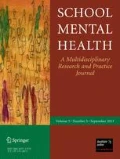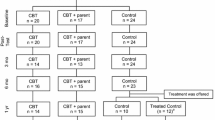Abstract
Preschoolers with elevated anxiety symptoms are at high risk not only of developing more severe mental health disorders in later life but are also apt to respond more poorly to intervention if they present with comorbid disruptive behavior. Because early signs of anxiety disorders may not be recognized as such in preschool settings, many children selected for Tier 2 interventions that target externalizing problem behaviors may also have co-occurring anxiety symptoms and disorders. The First Step to Success intervention has recently been adapted for preschoolers with externalizing behaviors and was found to be efficacious in a randomized controlled trial. The current report examines effects of the First Step intervention on a subsample of 38 preschoolers with comorbid anxiety symptoms. Compared to usual-care controls, preschoolers who were assigned to the First Step intervention demonstrated medium-to-large effects in reducing externalizing behavior and improving social functioning outcomes, but had small effects for reductions in internalizing behaviors. Implications for intervening with preschoolers at risk of comorbid disruptive and anxiety behaviors are discussed.
Similar content being viewed by others
References
American Psychological Association. (1994). Diagnostic and statistical manual (4th ed.). Washington, DC: American Psychiatric Association.
Bernstein, G. A., Bernat, D. H., Victor, A. M., & Layne, A. E. (2008). School-based intervention for anxious children: 3-, 6-, and 12-month follow-ups. Journal of the American Academy for Child and Adolescent Psychiatry, 47(9), 1039–1047. doi:10.1097/CHI.ob013e31817eecco.
Briesch, A. M., Ferguson, T. D., Volpe, R. J., & Briesch, J. M. (2013). Examining teachers’ perceptions of social-emotional and behavioral referral concerns. Remedial and Special Education, 34, 249–256. doi:10.1177/0741932512464579.
Bufferd, S. J., Dougherty, L. R., Carlson, G. A., Rose, S., & Klein, D. N. (2012). Psychiatric disorders in preschoolers: Continuity from ages 3 to 6. American Journal of Psychiatry, 169, 1157–1164. doi:10.1176/appi.ajp.2012.12020268.
Burke, M. D., Davis, J. L., Lee, Y.-H., Hagan-Burke, S., Kwok, O.-M., & Sugai, G. (2012). Universal screening for behavioral risk in elementary schools using SWPBS expectations. Journal of Emotional and Behavioral Disorders, 20(1), 38–54. doi:10.1177/1063426610377328.
Feil, E. G., Frey, A., Walker, H. M., Small, J. W., Seeley, J. R., Golly, A., et al. (2014). The efficacy of a home-school intervention for preschoolers with challenging behaviors. A randomized controlled trial of preschool First Step to Success. Journal of Early Intervention, 36, 151–170. doi:10.1177/1053815114566090.
Feil, E. G., Small, J. W., Seeley, J. R., Walker, H. M., Golly, A., Frey, A., et al. (2016). Early intervention for preschoolers at risk for attention-deficit/hyperactivity disorder: Preschool First Step to Success. Behavioral Disorders, 41(2), 95–106. doi:10.1177/1053815114566090.
Feil, E. G., Walker, H. M., & Severson, H. H. (1995). The early screening project for young children with behavior problems. Journal of Emotional and Behavioral Disorders, 3, 194–202. doi:10.1177/106342669500300401.
Fisak, B. J., Jr., Richard, D., & Mann, A. (2011). The prevention of child and adolescent anxiety: A metanalytic review. Prevention Science, 12, 255–268. doi:10.1007/s11121-011-0210-0.
Forness, S. R. (2011). Special education and the new mental health: A response to new direction of CCBD? Behavioral Disorders, 37(1), 41–46.
Franklin, M. E., Sapyta, J., Freeman, J. B., Khanna, M., Compton, S., Almirall, D., et al. (2011). Cognitive behavior therapy augmentation of pharmacotherapy in pediatric obsessive-compulsive disorder: The Pediatric OCD Treatment Study II (POTS II) randomized controlled trial. Journal of the American Medical Association, 306, 1224–1232. doi:10.1001/jama.2011.1344.
Franz, L., Angold, A., Copeland, W., Costello, E. J., Towe-Goodman, N., & Egger, H. (2013). Preschool anxiety disorders in pediatric primary care: Prevalence and comorbidity. Journal of the American Academy of Child and Adolescent Psychiatry, 52, 1294–1303. doi:10.1016/j.jaac.2013.09.008.
Frey, A. J., Small, J. W., Feil, E. G., Seeley, J. R., Walker, H. M., & Forness, S. (2015). First Step to Success: Applications to preschoolers at risk of developing autism spectrum disorders. Education and Training in Autism and Developmental Disabilities, 50, 397–407.
Frey, A. J., Small, J., Seeley, J., Feil, E., Walker, H. W., & Golly, A. (2013). The feasibility of First Step to Success with preschoolers. Children & Schools, 25(3), 171–188.
Gadow, K. D., & Sprafkin, J. (1997). Early childhood inventory-4 norms manual. Stony Brook, NY: Checkmate Plus.
Gadow, K. D., & Sprafkin, J. (2000). Early childhood inventory-4 screening manual. Stony Brook, NY: Checkmate Plus.
Gadow, K. D., Sprafkin, J., & Nolan, E. E. (2001). DSM-IV symptoms in community and clinic preschool children. Journal of the American Academy of Child and Adolescent Psychiatry, 40(12), 1383–1392. doi:10.1097/00004583-200112000-00008.
Garcia, A. M., Sapyta, J. J., Moore, P. S., Freeman, J. B., Franklin, M. E., March, J. S., et al. (2010). Predictors and moderators of treatment outcome in the Pediatric Obsessive Compulsive Treatment Study (POTS I). Journal of the American Academy of Child and Adolescent Psychiatry, 49, 1024–1033. doi:10.1016/j.jaac.2010.06.013.
Gilliam, W. S., Maupin, A. N., & Reyes, C. R. (2016). Early childhood mental health consultation: Results of a statewide random-controlled evaluation. Journal of the American Academy of Child and Adolescent Psychiatry, 55(9), 754–761. doi:10.1016/j.jaac.2016.06.006.
Golly, A. (2006). Five universal principles of positive behavior support and the story of my life. Verona, WI: Attainment Company.
Gresham, F. M., & Elliott, S. N. (2008). Social skills improvement rating scales manual. Bloomington, MN: Pearson Assessments.
Hudson, J. L., Keers, R., Roberts, S., Coleman, J. R. I., Breen, G., Arendt, K., et al. (2015). Clinical predictors of response to cognitive-behavioral therapy in pediatric anxiety disorders: The Genes for Treatment (GxT) study. Journal of the American Academy of Child and Adolescent Psychiatry, 54, 454–463. doi:10.1016/j.jaac.2015.03.018.
Killu, K., & Crundwell, R. M. A. (2016). Students with anxiety in the classroom: Educational accommodations and interventions. Beyond Behavior, 25, 30–40.
Luby, J. L. (2013). Treatment of anxiety and depression in the preschool period. Journal of the American Academy of Child and Adolescent Psychiatry, 52, 346–358. doi:10.1016/j.jaac.2013.01.011.
Mathews, T., Danese, A., Wertz, J., Ambler, A., Kelly, M., Diver, A., et al. (2015). Social isolation and mental health at primary and secondary school entry: A longitudinal cohort study. Journal of the American Academy of Child and Adolescent Psychiatry, 54(3), 225–232. doi:10.1016/j.jaac.2014.12.008.
McEvoy, P. M., Nathan, P., & Norton, P. J. (2009). Efficacy of transdiagnostic treatments: A review of published outcome studies and future research directions. Journal of Cognitive Psychotherapy, 23, 27–40. doi:10.1891/0889-8391.23.1.20.
McHugh, R. K., Murray, H. W., & Barlow, D. H. (2009). Balancing fidelity and adaptation in the dissemination of empirically-supported treatments: the promise of transdiagnostic interventions. Behaviour Research and Therapy, 47, 946–953. doi:10.1016/j.brat.2009.07.005.
Merikangas, K. R., He, J. P., Burstein, M., Swendsen, J., Avenevoli, S., Case, B., et al. (2011). Service utilization for lifetime mental disorders in U.S. adolescents: Results of the National Comorbidity Survey-Adolescent Supplement (NCSA). Journal of the American Academy of Child and Adolescent Psychiatry, 50(1), 32–45. doi:10.1016/j.jaac.2010.10.006.
Muthén, L. K., & Muthén, B. O. (1998-2012). Mplus user’s guide (7th ed.). Los Angeles, CA: Muthén & Muthén.
Piacentini, J., Bennett, S., Compton, S. N., Kendall, P. C., Birmaher, B., Albano, A. M., et al. (2014). 24- and 36-week outcomes for the Child/Adolescent Anxiety Multimodal Study (CAMS). Journal of the American Academy of Child and Adolescent Psychiatry, 53, 297–310. doi:10.1016/j.jaac.2013.11.010.
Rapee, R. M., Kennedy, S., Ingram, M., Edwards, S., & Sweeny, L. (2005). Prevention and early intervention of anxiety disorders in inhibited preschool children. Journal of Consulting and Clinical Psychology, 73, 488–497. doi:10.1037/0022-006X.73.3.488.
Rapee, R. M., Kennedy, S., Ingram, M., Edwards, S., & Sweeny, L. (2010). Altering the trajectory of anxiety in at-risk young children. American Journal of Psychiatry, 167, 1518–1525. doi:10.1176/appi.ajp.2010.09111619.
Rapee, R. M., Lyneham, H. J., Hudson, J. L., Kangas, M., Wuthrich, V. M., & Schniering, C. A. (2013). Effect of comorbidity on treatment of anxious children and adolescents: Results from a large, combined sample. Journal of the American Academy of Child and Adolescent Psychiatry, 52, 47–56. doi:10.1016/j.jaac.2012.10.002.
Ryan, N. D. (2014). Treating anxiety in youth: Does maintenance treatment maintain? Journal of the American Academy of Child and Adolescent Psychiatry, 53, 269–270. doi:10.1016/j.jaac.2013.11.008.
Schafer, J. L., & Graham, J. W. (2002). Missing data: Our view of the state of the art. Psychological Methods, 7, 147–177. doi:10.1037/1082-989X.7.2.147.
Schoenfeld, N. A., & Janney, D. M. (2008). Identification and treatment of anxiety in students with emotional or behavioral disorders: A review of the literature. Education and Treatment of Children, 31(4), 583–610. doi:10.1080/08856257.2011.543547.
Spence, S. H. (2003). Social skills training with children and young people: Theory, evidence and practice. Child and Adolescent Mental Health, 8(2), 84–96. doi:10.1111/1475-3588.00051.
Sprague, J. R., & Golly, A. (2013). Best behavior: Building positive behavior support in schools (2nd ed.). Frederick, CO: Sopris West Educational Services.
Sumi, W. C., Woodbridge, M. W., Javitz, H. S., Thornton, S. P., Wagner, M., Rouspil, K., et al. (2012). Assessing the effectiveness of First Step to Success: Are short-term results the first step to long-term behavioral improvements? Journal of Emotional and Behavioral Disorders, 21(1), 66–78. doi:10.1177/1063426611429571.
Towe-Goodman, N. R., Franz, L., Copeland, W., Angold, A., & Egger, H. (2014). Perceived family impact of preschool anxiety disorders. Journal of the American Academy of Child and Adolescent Psychiatry, 53, 437–446. doi:10.1016/j.jaac.2013.12.017.
U.S. Burden of Disease Collaborators. (2013). The state of U.S. health, 1990–2010. Burden of diseases, injuries and risk factors. Journal of the American Medical Association, 310, 591–608. doi:10.1001/jama.2013.13805.
Walker, H. M., & Gresham, F. M. (Eds.). (2014). Handbook of evidence-based practices for emotional and behavioral disorders. New York, NY: Guilford.
Walker, H. M., Horner, R. H., Sugai, G., Bullis, M., Sprague, J. R., Bricker, D., et al. (1996). Integrated approaches to preventing antisocial behavior patterns among school-age children and youth. Journal of Emotional and Behavioral Disorders, 4(4), 194–209.
Walker, H. M., Kavanagh, K., Stiller, B., Golly, A., Severson, H. H., & Feil, E. G. (1998). First Step to Success: An early intervention approach for preventing school antisocial behavior. Journal of Emotional and Behavioral Disorders, 6(2), 66–80. doi:10.1177/106342669800600201.
Walker, H. M., Seeley, J. R., Small, J., Severson, H. H., Graham, B. A., Feil, E. G., et al. (2009). A randomized controlled trial of the First Step to Success early intervention: Demonstration of program efficacy outcomes in a diverse, urban school district. Journal of Emotional and Behavioral Disorders, 17, 197–212. doi:10.1177/1063426609341645.
Walker, H., Severson, H., Seeley, J., Feil, E., Small, J., Golly, A., et al. (2014). The evidence base of the First Step to Success early intervention for preventing emerging antisocial behavior patterns. In H. Walker & F. Gresham (Eds.), Handbook of evidence-based practices for emotional and behavioral disorders (pp. 518–536). New York, NY: Guilford.
Weersing, V. R., Brent, D. A., Rozenman, M. S., Gonzaleez, A., Jefferys, M., Dickerson, J. F., et al. (2017). Brief behavioral therapy for pediatric anxiety and depression in primary care: A randomized clinical trial. JAMA Psychiatry, 74(6), 571–578. doi:10.1001/jamapsychiatry.2017.0429.
Wood, J. J., Piacentini, J. C., Southam-Gerow, M., Chu, B. C., & Sigman, M. (2006). Family cognitive behavioral therapy for child anxiety disorders. Journal of the American Academy of Child and Adolescent Psychiatry, 45(3), 314–321. doi:10.1097/01.chi.0000196425.88341.b0.
What Works Clearinghouse. (2011). Procedures and standards handbook (Version 2.1). Princeton, NJ: What Works Clearinghouse. Retrieved from ERIC database (ED565673) http://files.eric.ed.gov/fulltext/ED565673.pdf.
Funding
This study was funded by a Grant from the National Institute of Child Health and Human Development (R01HD055334).
Author information
Authors and Affiliations
Corresponding author
Ethics declarations
Conflict of interest
Drs. Feil, Walker, and Golly are three of the authors of the Preschool First Step to Success intervention.
Ethical Approval
All procedures performed in studies involving human participants were in accordance with the ethical standards of the institutional and/or national research committee and with the 1964 Helsinki Declaration and its later amendments or comparable ethical standards.
Informed Consent
Informed consent was obtained from all individual participants included in the study.
Rights and permissions
About this article
Cite this article
Seeley, J.R., Small, J.W., Feil, E.G. et al. Effects of the First Step to Success Intervention on Preschoolers with Disruptive Behavior and Comorbid Anxiety Problems. School Mental Health 10, 243–253 (2018). https://doi.org/10.1007/s12310-017-9226-3
Published:
Issue Date:
DOI: https://doi.org/10.1007/s12310-017-9226-3




